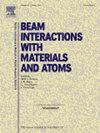Background subtraction in inelastic scattering measurements using machine learning
IF 1.4
3区 物理与天体物理
Q3 INSTRUMENTS & INSTRUMENTATION
Nuclear Instruments & Methods in Physics Research Section B-beam Interactions With Materials and Atoms
Pub Date : 2025-02-17
DOI:10.1016/j.nimb.2025.165649
引用次数: 0
Abstract
Identifying, isolating, and subtracting background from the signal of interest is vital for nuclear physics experiments. These backgrounds introduce unwanted uncertainties that must be accounted for properly to extract accurate results from the signals. In nuclear reaction measurements, the typical contaminants are carbon and oxygen, contributing to background signals, and complicating the measurement of the light ejectiles. For instance, in the inelastic scattering measurement of a 20.9-MeV proton beam on 96Mo, the 96Mo target was contaminated with carbon and oxygen. We used random forest, a machine learning algorithm commonly used for classification and regression tasks, to separate the inelastic scattering on the carbon and oxygen contaminants from the data of interest resulting from 96Mo().
基于机器学习的非弹性散射测量中的背景减法
从感兴趣的信号中识别、分离和减去背景对核物理实验至关重要。这些背景引入了不必要的不确定性,为了从信号中提取准确的结果,必须适当地考虑这些不确定性。在核反应测量中,典型的污染物是碳和氧,它们会产生背景信号,并使光抛射物的测量复杂化。例如,在20.9 mev质子束对96Mo的非弹性散射测量中,96Mo靶被碳和氧污染。我们使用随机森林(一种通常用于分类和回归任务的机器学习算法)将碳和氧污染物的非弹性散射从96Mo(p,p ')产生的感兴趣数据中分离出来。
本文章由计算机程序翻译,如有差异,请以英文原文为准。
求助全文
约1分钟内获得全文
求助全文
来源期刊
CiteScore
2.80
自引率
7.70%
发文量
231
审稿时长
1.9 months
期刊介绍:
Section B of Nuclear Instruments and Methods in Physics Research covers all aspects of the interaction of energetic beams with atoms, molecules and aggregate forms of matter. This includes ion beam analysis and ion beam modification of materials as well as basic data of importance for these studies. Topics of general interest include: atomic collisions in solids, particle channelling, all aspects of collision cascades, the modification of materials by energetic beams, ion implantation, irradiation - induced changes in materials, the physics and chemistry of beam interactions and the analysis of materials by all forms of energetic radiation. Modification by ion, laser and electron beams for the study of electronic materials, metals, ceramics, insulators, polymers and other important and new materials systems are included. Related studies, such as the application of ion beam analysis to biological, archaeological and geological samples as well as applications to solve problems in planetary science are also welcome. Energetic beams of interest include atomic and molecular ions, neutrons, positrons and muons, plasmas directed at surfaces, electron and photon beams, including laser treated surfaces and studies of solids by photon radiation from rotating anodes, synchrotrons, etc. In addition, the interaction between various forms of radiation and radiation-induced deposition processes are relevant.

 求助内容:
求助内容: 应助结果提醒方式:
应助结果提醒方式:


